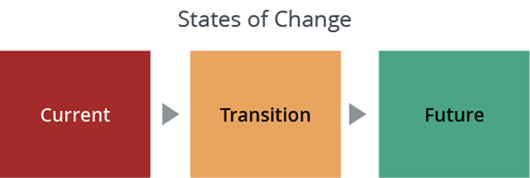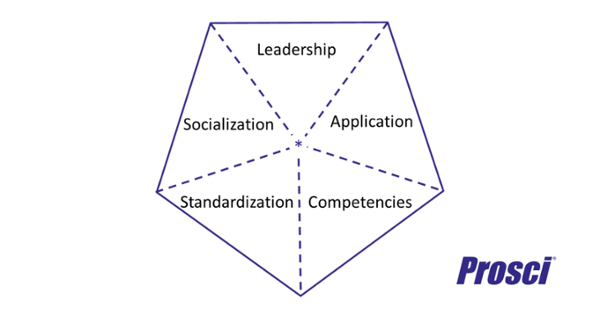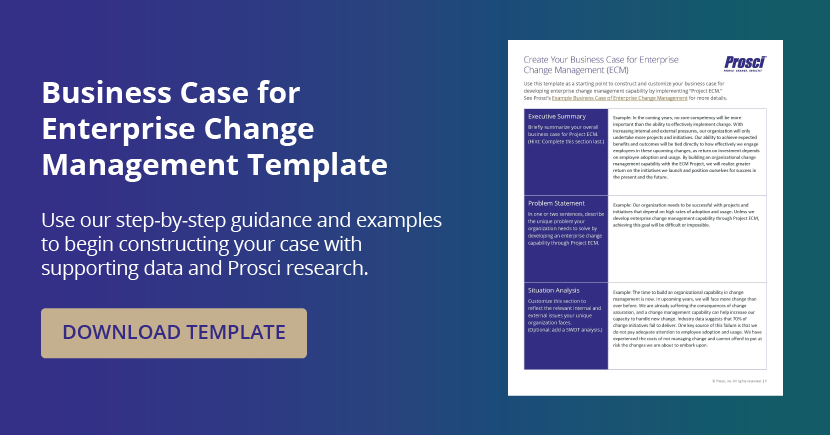3 Reasons Enterprise Change Management Efforts Fail

4 Mins
Updated: March 31, 2025
Published: July 28, 2021

Leading organizations are investing time, energy and resources to build the enterprise change capabilities that will help them grow more adaptable and agile in today's ever-changing world. But deploying change management across the enterprise is not the same as applying change management to projects or even many large-scale projects at once. It is a significant undertaking that can yield tremendous returns for your organization when done well—or cause common failures when done poorly.
Enterprise Change Failures To Avoid
Enterprise Change Management (ECM) is the systematic deployment of change management skills, tools and processes throughout an organization. Although it may be a new endeavor for some, Prosci has been researching and applying ECM principles and approaches since 2005. While conducting this research and working with clients, we have witnessed avoidable failures you can learn from. Here are the three main failure modes and what to do about them.
Failure mode 1: Not treating ECM as a project and a change
Many organizations that are making tremendous progress at applying change management on specific initiatives will never make the breakthrough to ECM because they're not treating it like its own project and change to be managed. They're chipping away but have not turned the corner toward deploying change management organizationally.
Treating enterprise change management as a project and a change means applying the full complement of tools available to manage any project or initiative.
- Does ECM have a charter?
- Does ECM have objectives?
- Is there a work breakdown structure for ECM?
- Is there a project plan for ECM?
- Is there a change management plan for ECM?
To truly build organizational change management capabilities, the initiative must be addressed and managed as an enterprise effort with the necessary design and planning.
Organizational change also requires assigning people to take on the effort. Does it have a project leader? A project team? A project manager? The ECM team members are not just any people in the organization who will be doing change management. The ECM team is a dedicated and passionate group of people who work to understand the current state, design the future state, and develop tactics for the transition state of enterprise change management. The team should have or gain knowledge on how changes happen and how change management can be made part of the standard operating procedures for the organization. Without a team dedicated to the effort, it will get no traction.

Finally, when you ask individuals throughout the organization to begin applying change management, you're asking them to make a change. Like any other change to one's day-to-day work, change management is needed to ensure faster speed of adoption, higher ultimate utilization, and greater proficiency.
- Are you making a compelling case for why change management is necessary?
- Are you clearly articulating what people need to be doing to support change management?
- Are you providing the necessary skills, training and tools to those who will be managing change?
The people side of the "applying change management" change itself will be as critical as any design decisions the team makes.
Actions steps to avoid failure mode 1:
- Dedicate a project team
- Design a solution for deployment
- Build a project plan
- Build a change management plan

Failure mode 2: Not defining the future state
A second major failure mode comes from trying to build the capability without ever defining the goal or what the end state will look like. In other words, failing to define the future state of enterprise change management.
Although the future state of enterprise change management will be unique to your organization, you still must define what you're trying to achieve. The old saying, "If you don't know where you are going, any road will lead you there" certainly applies to organizations working to deploy change management without a defined future state.
If I were to walk through your organization in three years after you have spent the time and energy working to deploy change management, what would I see? What would I observe in the organization to know that you were institutionalizing change management and making "effectively managing change" part of the way your organization operates? The answers to these questions are at the heart of defining the future state of enterprise change management.
Defining a future state requires the deliberate decision that you, as an organization, are taking on enterprise change management. The deliberate decision enables you to start articulating what the future state would be like and how you would know when you have arrived.
Action steps for avoiding failure mode 2:
- Ensure that a deliberate decision is made to pursue ECM
- Define the future state
- Know where you are going
Failure mode 3: Not using a multi-faceted approach
The final failure mode can be best summarized by another old saying, "When all you have is a hammer, everything looks like a nail." Some organizations are working to build change management capabilities, but they're not using the full set of tools available to them.
One organization may have a robust and complete change management curriculum but no method for attaching change management to projects or initiatives. Another may have a wonderfully integrated methodology incorporating project management and change management but no offerings to help managers, supervisors and senior leaders build their own personal competencies. Still another might have a formal change management office (CMO) but nothing else.
A successful enterprise change management deployment approach is comprehensive in nature. It utilizes numerous tactics and approaches for making change management "business as usual" for the organization. Prosci's ECM Strategy Map identifies five main areas where actions are required to build change management capabilities: Leadership, Project, Skill, Structure and Process.
ECM Framework

In the absence of a holistic approach, the likelihood of successful and lasting change is minimal.
You should always be aware of your default view going into a change management deployment effort. What does this mean? If you are in the training and development part of the organization, you might think about change management capability from a perspective of building skills and competencies throughout the organization. If you are the director of the project management office (PMO), you would likely think of change management capability from a perspective of integration with project management and tactics for getting change management on to projects. If you are a senior leader, you might be thinking about restructuring and creating a CMO within your organizational effectiveness group. There's nothing wrong with having a default perspective, but it's important that you acknowledge yours and expand your planning beyond it.
Action steps for avoiding failure mode 3:
- Understand your default view
- Use all the tools you have available to make change management part of how the organization views change
- Collaborate with others in the organization who bring different viewpoints and perspectives
Change Management as an Enterprise Capability
Becoming a flexible and durable organization, where effectively managing the people side of change permeates how changes take place, is not an easy task. It takes time, energy and people. It requires a deliberate decision and the appropriate authority and sponsorship. But many organizations are beginning to create competitive advantages through change management capabilities and competencies.
Treat ECM as a project and a change, define the future state, and use a multi-faceted approach. If you take these steps in your efforts to deploy change management across the organization, you will greatly increase your chances of success and truly change how your organization "does change."



